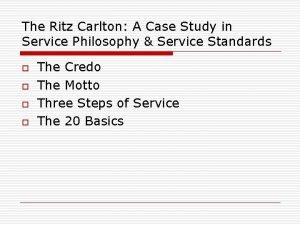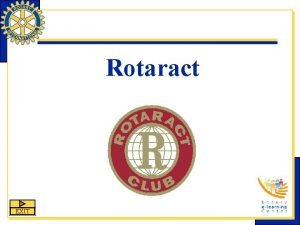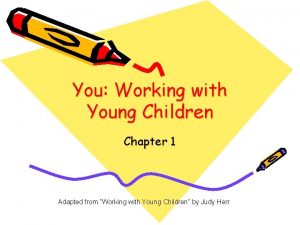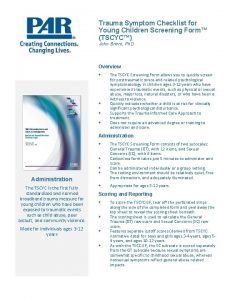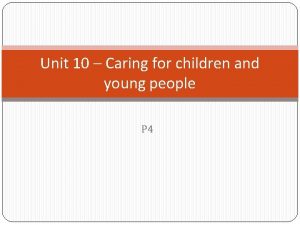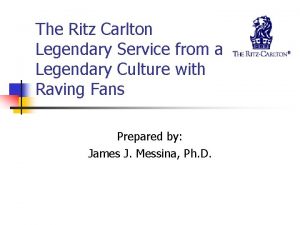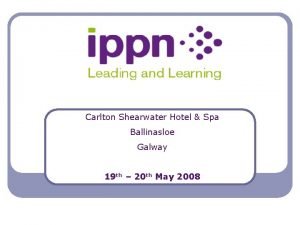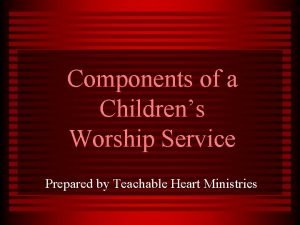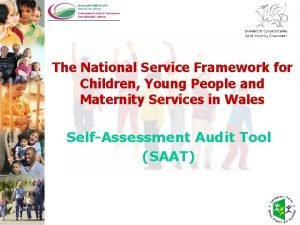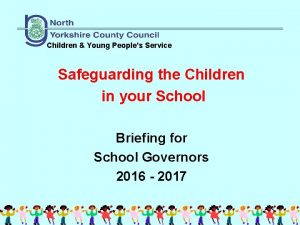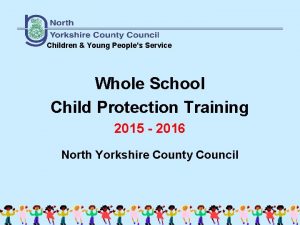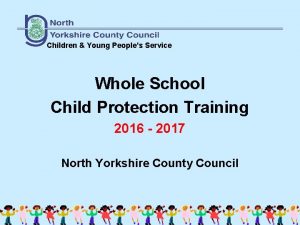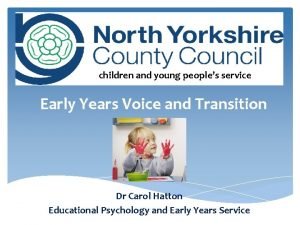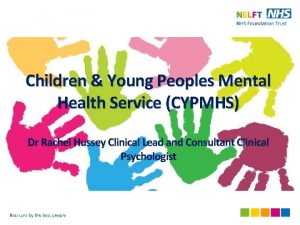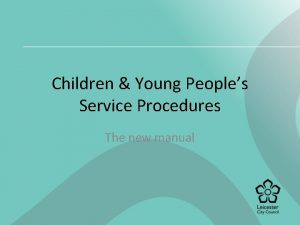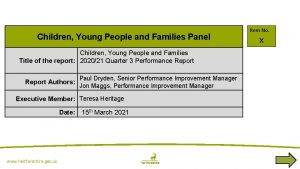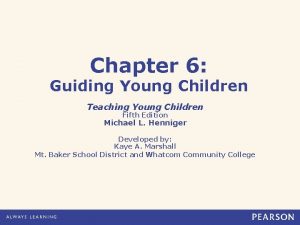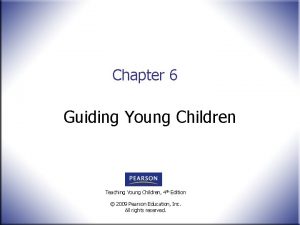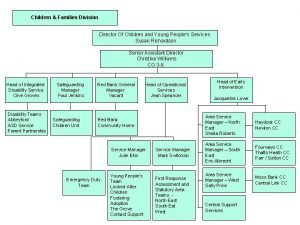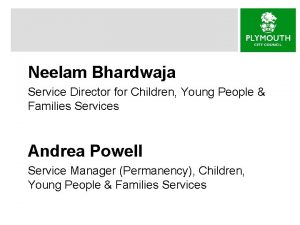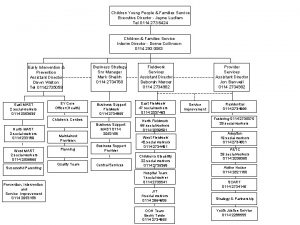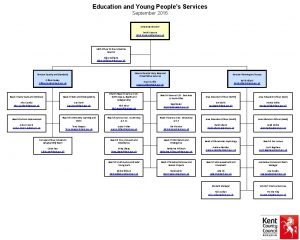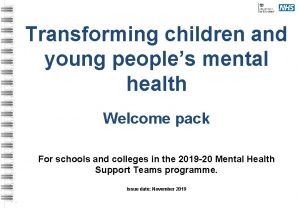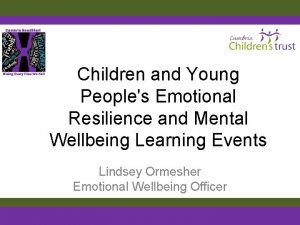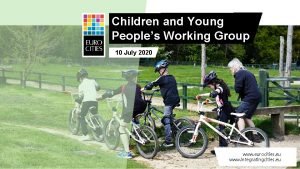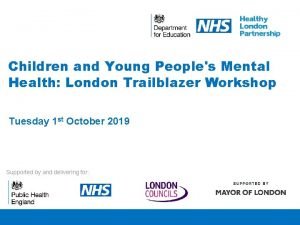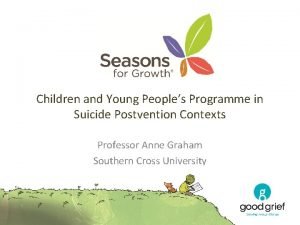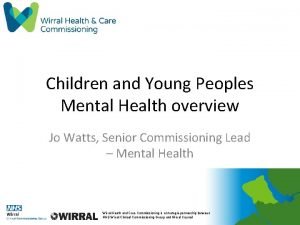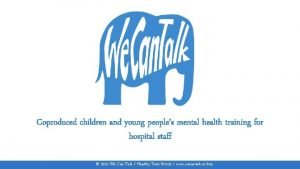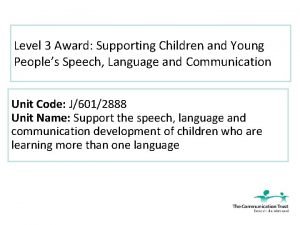Stuart Carlton Corporate Director Children Young Peoples Service

























- Slides: 25

Stuart Carlton Corporate Director Children & Young People’s Service

Will add a crowd photograph from the morning

Will add a crowd photograph from the morning Will add a signing up for workshops photograph from th morning

Will add a parent plus young person plus professional interaction from the morning

Why does early language matter? The link between language and other social, emotional and learning outcomes makes early language a primary indicator of child wellbeing Difficulties in one area of development lead to problems with the others Educational disadvantage: Communication is the key to access learning Reduced school readiness/ Poor academic achievement Emotional and behavioural difficulties Increased risk of ADHD and anxiety disorders in adolescence Difficulties in early language development are Risky associated with a range ofbehaviours long term outcomes. This More than 70% of young people in the youth offenders system a communication can impact on a child’shave health and disability behaviour but also Criminal prospects Justice Social Emotionaland social economic in future life. 50% of the UK prison population have language difficulties Learning Speech Language Communication (compared to 17% of general population) Economic disadvantage 12% lower earnings due to inadequate literacy skills Twice as likely to be unemployed at age 34 Mental Health problems 3 x Increased risk of mental health problems in adulthood

Age & Stages Questionnaire (2 to 2 ½ years)

North Yorkshire performance Percentage of children achieving a Good Level of Development (2017) North Yorkshire National Yorkshire & Humber Statistical neighbours Top performing (average of top 10) % 71. 6% 70. 7% 68. 8% 72. 5% 77. 4% NY rank n/a 58/151 4/15 7/11 n/a The total Early Years cohort was 6, 196 pupils; 4, 443 pupils achieved a GLD and 1, 753 did not.

North Yorkshire performance Percentage of children achieving a Good Level of Development (2017) North Yorkshire National Yorkshire & Humber Statistical neighbours Top performing (average of top 10) % 71. 6% 70. 7% 68. 8% 72. 5% 77. 4% NY rank n/a 58/151 4/15 7/11 n/a The total Early Years cohort was 6, 196 pupils; 4, 443 pupils achieved a GLD and 1, 753 did not.

Achieving a Good Level of Development by District 2015 2016 2017 Difference Since 2015 Craven 68. 5% 71. 0% 71. 9% 3. 4% Hambleton 69. 3% 72. 1% 71. 5% 2. 2% Harrogate 68. 0% 73. 5% 73. 6% 5. 6% Richmondshire 66. 5% 67. 5% 71. 9% 5. 4% Ryedale 65. 9% 66. 8% 68. 5% 2. 6% Scarborough 62. 3% 62. 8% 66. 4% 4. 1% Selby 65. 4% 72. 2% 76. 0% 10. 6% North Yorkshire 66. 6% 70. 0% 71. 6% 5. 0% National 66. 0% 69. 0% 70. 7% 4. 7%

District analysis • Selby has the highest percentage of pupils achieving a GLD (76%). The performance for Selby would rank the district 12 th out of 152 in the country. • Scarborough (66. 4%) and Ryedale (68. 5%) have the lowest percentage of pupils achieving a GLD. The performance for Scarborough would rank the district 129 th out of 152 in the country.

Vulnerable Learners l l A stark social mobility postcode lottery exists in Britain today, where the chances of being successful if you come from a disadvantaged background are linked to where you live. (Social Mobility Commission, State of the Nation 2017) Disadvantaged children arrive at school months behind and finish secondary school 2 years behind

Vulnerable learners l The percentage of children achieving a GLD is much lower for certain vulnerable groups: - - 61. 3% of children with English as an Additional Language 53. 2% of disadvantaged pupils 21. 1% of children receiving SEN support 10. 9% of children with an Education, Health & Care Plan

Differences start early • By age 3 there is already a 17 month income-related language gap. • Language development at the age of 2 strongly predicts children’s performance on entry to primary school. Roulstone et al , 2011, Investigating the role of language in children’s early educational outcomes, Df. E Research Report Source: Hart, B. , & Risley, T. (1995). Meaningful differences in the everyday experiences of young American children. Baltimore, MD: Brookes.

Inequalities in Speech, language and communication Children from disadvantaged families are as likely to experience language delay 5 -8% of all children in England have speech and/or language impairment 2 X Children from higher income families have heard over 50% In areas of deprivation up to of children start school with language delay 14 30 million more words by age 3 years Health Readiness – Language is a primary indicator of health and wellbeing

Language and poverty The child’s communication environment (the early ownership of books, trips to the library, attendance at pre-school, parents teaching a range of activities and the number of toys and books available) was a more important predictor of language development at two, and school entry ‘baseline’ scores at 4 than socio-economic background. Roulstone et al (2011)Investigating the role of language in children’s early educational outcomes 15 Health Readiness – Language is a primary indicator of health and wellbeing

What would difference? l l it take to make a 264 additional children achieving a GLD would have ranked us 1 st against our statistical neighbours. This equates to less than one pupil per school. 466 additional children achieving a GLD would have ranked us 1 st in the country. This equates to less than two pupils per school.

Where could we focus? l l l On average 454 pupils per year who did not achieve a GLD are assessed as emerging in only one or two of the twelve Early Learning Goals used for assessment. The majority of this cohort are assessed as emerging in writing and/or reading. In 2017 a total of 960 children who did not achieve a GLD missed at least one of the three Early Learning Goals under the Communication & Language Area of Learning.

School Performance l l There is a marked variation in performance between schools. In the lowest performing school 40% achieved a GLD, where as in the best performing school 91. 7% achieve a GLD. School leadership is crucial –One Scarborough Primary School has seen an improvement in % of children achieving a GLD from 47. 6% in 2015 to 61. 9% in 2016 to 81. 8% in 2017.

Language as a Child Wellbeing Indicator l Over the past 10 years, evidence concerning the strong link between early language development and later-life outcomes has resulted in several calls to prioritise early language skills as a primary child wellbeing indicator. EIF, Sept 2017

A new pathway? Health Visiting: 5 Mandated universal reviews Promote responsive Promote a language parenting rich home environment Identify children in need of additional support Antenatal contact New Birth visit Interventions to improve the quality of the parent child interaction Signpost to specialist support if needed 6 -8 weeks 10 -12 months Support transition to school and handover to school nursing service Workforce training Language Assessment Tool 2 -2. 5 Year review Early Years Foundation Stage (EYFS): Progress checks and Profile Language rich early environments and high quality Early Years provision Communication and language: A prime learning and development area 2 year progress check Review against expected levels of development Early years Foundation Stage 4+ A coordinated local response: No child gets left behind Targeted plan for children with speech, language and communication needs

Current projects Overdale project- 70% of children had delayed language in nurserygap closed to 20% following intervention using language link and our EY SLCN pathway Results from this pathway of early ID are outstanding Autism Early Impact programme – enhanced and early home based input Developing access to peers who sign for our Deaf children SEND strategy- SLCN is a clear priority in developing provision

Current Projects Through screening our Youth Justice and Looked after children cohorts, we know that the levels of hidden SLCN are high l l l We know if we address communication it will have a cross cutting impact School readiness project……and beyond

The North Yorkshire Strategic Plan for SEND Education Provision 0 -25 public consultation to 28 th June All children and young people in North Yorkshire aged. Public 0 -25 who have SEND consultation The families of. May these children and June young people 2018 All those who work with these children and young people

Principles Is this provision good enough for my child? An inclusive culture and ethos Joint commitment Right support, and right time, right accountability to place children and young people

Strategic plan – outcomes Overall outcomes Improved educational, social, emotional and health outcomes for children and young people with SEND. Increased parental confidence in the continuum of SEND provision in North Yorkshire. Supporting outcomes Early identification of SEND through high quality, robust assessment of children and young people’s needs. More children and young people with SEND have sustained placements in local settings, schools and colleges that are judged good or outstanding by OFSTED. All education providers are able to effectively support a range of special educational needs and disabilities. Effective local area partnership governance arrangements to ensure SEND provision meets local needs and partners are jointly accountable.
 Mr biv ritz carlton
Mr biv ritz carlton Rotaract club activities
Rotaract club activities Working with young children/answer key chapter 1
Working with young children/answer key chapter 1 Trauma symptom checklist for young children
Trauma symptom checklist for young children Phonemic awareness in young children
Phonemic awareness in young children Eyfs moodle hampshire
Eyfs moodle hampshire Unit 10 caring for children and young people
Unit 10 caring for children and young people Alcohol consumption causes blood vessels to contract.
Alcohol consumption causes blood vessels to contract. Corporate finance objectives
Corporate finance objectives Ritz carlton credo
Ritz carlton credo Service-driven
Service-driven Carlton draught ad
Carlton draught ad Carlton shearwater hotel ballinasloe
Carlton shearwater hotel ballinasloe Carlton comprehensive high school class schedule
Carlton comprehensive high school class schedule The carlton junior academy
The carlton junior academy Jermaine carlton
Jermaine carlton Tuition in carlton
Tuition in carlton Fred carlton field
Fred carlton field Gshrm
Gshrm Carlton comprehensive high school math
Carlton comprehensive high school math Carlton comprehensive high school calendar
Carlton comprehensive high school calendar Basic shooting skills
Basic shooting skills Children's worship service outline
Children's worship service outline National service framework children
National service framework children Arab social structure
Arab social structure Maturity continuum victories
Maturity continuum victories
